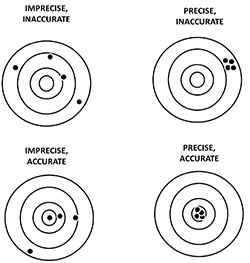Age Error Assessment
Last modified on Aug 13, 2019
Salmon scale ages are often analyzed and reported without estimate of error, including precision, accuracy, and bias. Annual age compositions are often estimated by seasonal technicians with limited budgets and time and no set procedures for estimating these rates. In the Wiki, we discuss methods for training readers to minimize error and assess precision and bias and provide some suggestions for assessing these factors.
Evaluation of age estimations needs to consider not just consistency or repeatability (precision) but bias and accuracy as well:
- precision, repeatability of age estimates;
- accuracy, closeness of the age estimates to the true value, which is often unknown in age estimation studies; and
- bias, differences among ages. There are two types of bias, systematic and non-linear. An example of systematic bias is consistently under-estimating all ages by one year. An example of non-linear bias is tending to over-estimate the ages of smaller fish. It is important to evaluate both types of bias.
For more details:

